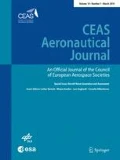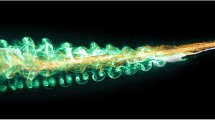Abstract
Aircraft wake vortex evolution in ground proximity is investigated experimentally in a water towing tank, as well as numerically with wall-resolved large eddy simulation (LES). With these complementary instruments the enhancement of wake vortex decay by obstacles, introduced at the ground surface, is analyzed. The experimental methods include time-resolved stereo particle image velocimetry and vortex core visualization. For comparison with the experiment, the LES considers the turbulent wake of the strut, holding the towed aircraft model. Wake vortex trajectories and circulation decay are compared at different distances from the obstacle. Tracers are employed to visualize the obstacle’s effects on the vortex core, in LES and experiment. The experimentally obtained trajectories and decay characteristics are reproduced qualitatively by simulations, whereas the agreement is degraded at later times. Beyond that, the vortex dynamics, deduced from the LES results, help to understand the experimental observations. The obstacles trigger helical secondary vortex structures, propagating along the primary vortices. The observed propagation speed of the helical disturbance is fairly well predicted by the suggested simple model. It is shown that the obstacles significantly modify the vortex interaction with the ground and substantially accelerate vortex decay. Two neighboring obstacles lead to colliding disturbances that further enhance vortex decay rates.


















Similar content being viewed by others
Notes
In a distance of \(\Updelta x^*=1.05\) not enough data could be acquired after t* = 3 to evaluate statistics.
Abbreviations
- \(\varGamma\) :
-
Circulation, m2/s
- \(\varGamma_0\) :
-
Initial vortex circulation, m2/s
- \(\nu\) :
-
Molecular viscosity, m2/s
- \(\nu_{\rm t}\) :
-
Turbulent viscosity, m2/s
- ω :
-
Vorticity, 1/s
- ω x , ω y , ω z :
-
Vorticity components, 1/s
- ρ :
-
Density, kg/m3
- σ:
-
Standard deviation
- a :
-
Radius of secondary vortex structure, m
- A, B :
-
Parameters for strut wake turbulence model
- b 0 :
-
Initial vortex separation, m
- C :
-
Chord length, mm
- C D :
-
Drag coefficient, 1/m
- d :
-
Chord thickness, mm
- E strut :
-
Turbulent kinetic energy of strut wake, Nm
- \(E_\varGamma\) :
-
Turbulent kinetic energy of the vortex, Nm
- h 0 :
-
Initial vortex height, m
- L x , L y , L z :
-
Dimensions, m
- l strut :
-
Length of the strut, m
- N x , N y , N z :
-
Grid points
- p :
-
Pressure, N/m2
- R :
-
Curvature radius, m
- \(Re_\varGamma\) :
-
Vortex Reynolds number
- \(Re_{\rm c}\) :
-
Chord Reynolds number based on towing speed
- r c :
-
Vortex core radius, m
- t :
-
Time, s
- t 0 :
-
Time unit, s
- U 0 :
-
Towing speed, m/s
- u i , u, v, w :
-
Velocity components, m/s
- U hel :
-
Propagation speed of helix front, m/s
- V 0 :
-
Initial vortex descent speed, m/s
- x i , x, y, z :
-
Coordinates, m
- \(\Updelta x\) :
-
Distance to obstacle, m
- 0:
-
Reference state
- max:
-
Maximum value
- rms:
-
Root mean square
- hel:
-
Helix
- L:
-
LES
- ring:
-
Ring
- W:
-
WSG
- ′:
-
Deviation from reference state
- *:
-
Normalized with respect to vortex flow
- +:
-
Normalized by chord length
- DLR:
-
German Aerospace Center
- ICAO:
-
International Civil Aviation Organization
- LES:
-
Large-eddy simulation
- PIV:
-
Particle image velocimetry
- SVS:
-
Secondary vortex structure
- WSG:
-
Wasser Schleppkanal Göttingen
- WVAS:
-
Wake vortex advisory system
References
Gerz, T., Holzäpfel, F., Bryant, W., Köpp, F., Ferch, M., Tafferner, A., Winckelmans, G.: Research towards a wake-vortex advisory system for optimal aircraft spacing. C. R. Phys. 6(4–5), 501–523 (2005)
Gerz, T., Holzäpfel, F., Darracq, D.: Commercial aircraft wake vortices. Prog. Aerosp. Sci. 38(3), 181–208 (2002)
Spalart, P.: Airplane trailing vortices. Annu. Rev. Fluid Mech. 30(1), 107–138 (1998)
Critchley, J., Foot, P.: UK CAA wake vortex database: analysis of incidents reported between 1982 and 1990. Civil Aviation Authority, CAA Paper, vol. 91 (1991)
Holzäpfel, F., Steen, M.: Aircraft wake-vortex evolution in ground proximity: analysis and parameterization. AIAA J. 45, 218–227 (2007)
Robins, R., Delisi, D.: Potential hazard of aircraft wake vortices in ground effect with crosswind. J. Aircr. 2, 201–206 (1993)
Türk, L., Coors, D., Jacob, D.: Behavior of wake vortices near the ground over a large range of reynolds numbers. Aerosp. Sci. Technol. 3(2), 71–81 (1999)
Harvey, J., Perry, F.: Flowfield produced by trailing vortices in the vicinity of the ground. AIAA J. 9(8), 1659–1660 (1971)
Dufresne, L., Baumann, R., Gerz, T., Winckelmans, G., Moet, H., Capart, R.: Large eddy simulation of wake vortex flows at very high reynolds numbers: a comparison of different methodologies. Technical Report, AWIATOR, D1.14-16 (2005)
Proctor, F.H., Hamilton, D.W., Han, J.: Wake vortex transport and decay in ground effect: Vortex linking with the ground. In: AIAA, 2000-0757, 38th Aerospace Sciences Meeting & Exhibit, Reno (2000)
Spalart, P., Strelets, M., Travin, A., Shur, M.: Modelling the interaction of a vortex pair with the ground. Fluid Dyn. 36(6), 899–908 (2001)
Stephan, A., Holzäpfel, F., Misaka, T.: (2013) Aircraft wake vortex decay in ground proximity—physical mechanisms and artificial enhancement. J. Aircr . http://arc.aiaa.org/doi/abs/10.2514/1.J051609. Accessed 19 June 2013
Coustols, E., Stumpf, E., Jaquin, L., Moens, F., Vollmers, H., Gerz, T.: Minimized wake: a collaborative research programme on aircraft wake vortices. AIAA Paper 2003-0938 (2003)
Stumpf, E.: Study of four-vortex aircraft wakes and layout of corresponding aircraft configurations. J. Aircr. 42, 722–730 (2005)
Breitsamter, C.: Wake vortex characteristics of transport aircraft. Prog. Aerosp. Sci. 47, 89–134 (2011)
Duponcheel, M., Lonfils, T., Bricteux, L., Winckelmans, G.: Simulations of three-dimensional wake vortices in ground effest using a fourth-order incompressible code. In: 7th National Congress on Theoretical and Applied Mechanics, Mons (2006)
Georges, L., Geuzaine, P., Duponchel, M., Bricteux, L., Lonfils, T., Winckelmans, G., Giovannini, A.: Technical report 3.1.1-3, les of two-vortex system in ground effect with and without wind. Technical Report, Université catholique de Louvain (UCL), Institut de Mécanique des Fluides de Toulouse (IMFT) (2005)
Delisi, D.P.: Laboratory measurements of the effect of ambient turbulence on trailing vortex evolution. In: 44th AIAA Aerospace Sciences Meeting and Exhibits, San Reno (2006)
Cottin, C., Desenfans, O.G.D., Winckelmans, G.: Towing-tank visualization of two-vortex systems in ground effect. Technical Report, FAR-Wake, Université Catholique de Louvain (UCL) (2007)
Konrath, R., Carmer, C., Schrauf, G., Schmidt, K., Winckelmans, G., Cottin, C., Desenfans, O.G.D., Cocle, R.: Dynamics and decay of spatially-evolving two- and four-vortex wakes near the ground. Technical Report, FAR-Wake project deliverable D 3.1.2 (2008)
Hah, C., Lakshminarayana, B.: Measurement and prediction of mean velocity and turbulence structure in the near wake of an airfoil. J. Fluid Mech. 115, 251–282 (1982)
Zhang, Q., Lee, S.W., Ligrani, P.M.: Effects of surface roughness and freestream turbulence on the wake turbulence structure of a symmetric airfoil. Phys. Fluids 16(6), 2044–2053 (2004)
Manhart, M.: A zonal grid algorithm for dns of turbulent boundary layer. Comput. Fluids 33(3), 435–461 (2004)
Meneveau, C., Lund, T.S., Cabot, W.H.: A lagrangian dynamic subgrid-scale model of turbulence. J. Fluid Mech. 319, 353–385 (1996)
Holzäpfel, F.: Adjustment of subgrid-scale parametrizations to strong streamline curvature. AIAA J. 42(7), 1369–1377 (2004)
Shen, S., Ding, F., Han, J., Proctor, F.H.: Numerical modeling studies of wake vortices: real case simulations. In: 37th AIAA Aerospace Sciences Meeting and Exhibit. Reno, Nevada, USA (1999)
Hokpunna, A., Manhart, M.: Compact fourth-order finite volume method for numarical solutions of Navier–Stokes equations on staggered grids. J. Comput. Phys. 229(20), 7545–7570 (2010)
Misaka, T., Holzäpfel, F., Gerz, T.: Wake evolution of wing-body configuration from roll-up to vortex decay. In: 50th AIAA Aerospace Sciences Meeting including the New Horizons Forum and Aerospace Exposition, Nashville, Tennessee, USA., 2012-0428, pp. 1–15 (2012)
Béchara, W., Bailly, C., Lafon, P.: Stochastic approach to noise modeling for free turbulent flows. AIAA J. 32(3), 455–463 (1994)
de Bruin, A., Winckelmans, G.: Cross-flow kinetic energy and core size growth of analytically defined wake vortex pairs. Technical Report, NLR-CR-2005-412, NLR (2005)
Holzäpfel, F., Hofbauer, T., Darracq, D., Moet, H., Garnier, F., Ferreira Gago, C.: Analysis of wake vortex decay mechanisms in the atmosphere. Aerosp. Sci. Technol. 7, 263–275 (2003)
Misaka, T., Holzäpfel, F., Hennemann, I., Gerz, T., Manhart, M., Schwertfirm, F.: Vortex bursting and tracer transport of a counter-rotating vortex pair. Phys. Fluids 24, 025,104-1–025,104-21 (2012)
Holzäpfel, F.: Probabilistic two-phase wake vortex decay and transport model. J. Aircr. 40(2), 323–331 (2003)
Konrath, R., Pallek, D., Mattner, H., v. Cramer C.: Analysis of flow field measurements obtained in a large tow tank regarding the decay of wake vortices in the far-field for two- and four-vortex systems. In: AIAA-Paper 2009-342, 47th AIAA Aerospace Science Meeting, Orlando (Florida) (2009)
Holzäpfel, F., Gerz, T., Baumann, R.: The turbulent decay of trailing vortex pairs in stably stratified environments. Aerosp. Sci. Technol. 5(2), 95–108 (2001)
Moet, H., Laporte, F., Chevalier, G., Poinsot, T.: Wave propagation in vortices and vortex bursting. Phys. Fluids 17, 054,109 (2005)
Lamb, H.: Hydrodynamics. Cambridge University Press, London (1957)
Acknowledgments
The simulations have been performed using supercomputers at Leibniz-Rechenzentrum (LRZ). We would like to thank Prof. M. Manhart for providing the original version of the LES code MGLET. The work was funded by DLR project Wetter & Fliegen.
Author information
Authors and Affiliations
Corresponding author
Rights and permissions
About this article
Cite this article
Stephan, A., Holzäpfel, F., Misaka, T. et al. Enhancement of aircraft wake vortex decay in ground proximity. CEAS Aeronaut J 5, 109–125 (2014). https://doi.org/10.1007/s13272-013-0094-8
Received:
Revised:
Accepted:
Published:
Issue Date:
DOI: https://doi.org/10.1007/s13272-013-0094-8




